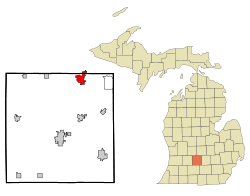
Clinton County is a county in the U.S. state of Michigan. As of the 2020 Census, the population was 79,128. The county seat is St. Johns. The county was created in 1831 and organized in 1839. It is named after early American politician DeWitt Clinton. Clinton County is included in the Lansing-East Lansing, MI Metropolitan Statistical Area.

Ingham County is a county located in the U.S. state of Michigan. As of the 2020 Census, the population was 284,900. The county seat is Mason. Lansing, the state capital of Michigan, is largely located within the county. The county is home to Michigan State University, Lansing Community College, and the Class A minor league baseball team Lansing Lugnuts. Ingham County is included in the Lansing–East Lansing, MI Metropolitan Statistical Area. It is considered to be a part of Mid Michigan.
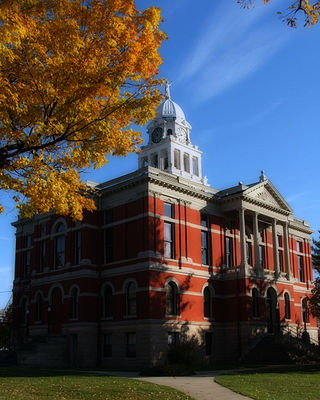
Eaton County is a county in the U.S. state of Michigan. As of the 2020 United States Census, the population was 109,175. The county seat is Charlotte. The county was organized in 1837 and was named for John Eaton, who was Secretary of War under U.S. President Andrew Jackson, making it one of Michigan's Cabinet counties. Eaton County is included in the Lansing-East Lansing, Metropolitan Statistical area in Central Michigan.

Lansing is a city in Lansing Township, Allamakee County, Iowa, United States. The population was 968 at the time of the 2020 census.

Munising is a city in Alger County in the U.S. state of Michigan. The population was 2,355 at the 2010 census. It is the county seat of Alger County. The city is partially surrounded by Munising Township, but the two are administered autonomously.

Bath Charter Township is a charter township of Clinton County in the U.S. state of Michigan. As of the 2010 census, the township population was 11,598, which is a large increase from 7,541 at the 2000 census. It is situated directly north of the city of East Lansing.

Eagle Township is a civil township of Clinton County in the U.S. state of Michigan. The population was 2,671 at the 2010 census.
Delta Charter Township, officially known as the Charter Township of Delta and commonly known as simply Delta Township, is a charter township of Eaton County in the U.S. state of Michigan. As of the 2020 census, it had a population of 33,119 making it the most populous municipality in Eaton County. The township operates its own fire department, but contracts with the Eaton County Sheriff Department for police protection. The township is a major community in metropolitan Lansing.

Eaton Rapids is a city in Eaton County in the U.S. state of Michigan. The population was 5,214 at the 2010 census.

Potterville is a city in Eaton County in the U.S. state of Michigan. The population was 2,617 at the 2010 census.

Delhi Charter Township is a charter township of Ingham County in the U.S. state of Michigan. The population was 27,710 at the 2020 census, an increase from 25,877 in 2010 census.
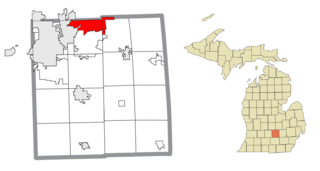
Haslett is a census-designated place (CDP) in Ingham County in the U.S. state of Michigan. It is located mostly within Meridian Charter Township with a small portion extending east into Williamstown Township. The population was 19,220 at the 2010 census. Haslett contains its own school district, as well as its own post office with the 48840 ZIP Code.
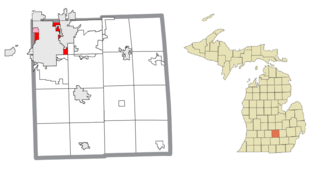
Lansing Charter Township is a charter township of Ingham County in the U.S. state of Michigan. The population was 8,143 at the 2020 census.

Williamston is a city in Ingham County in the U.S. state of Michigan. The population was 3,854 at the 2010 census. Williamston is located east of the city of Lansing and borders Williamstown Township to the north and Wheatfield Township to the south. The Red Cedar River and M-43 run through the center of the city.
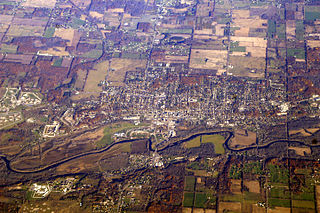
Ionia is the largest city in, and the county seat of, Ionia County, Michigan, United States. The population was 13,378 at the 2020 census. Every July it hosts what is said to be the world's largest free-admission fair. The city is mostly within Ionia Township, with small portion extending into Easton Township and Berlin Township, but is politically autonomous of the townships.

Portland is a city in Ionia County of the U.S. state of Michigan. The population was 3,883 at the 2010 census. The city is situated in the south central portion of Portland Township and is known as the "City of Two Rivers" since it is the confluence of the Grand River and the Looking Glass River. Portland is home to Portland Public Schools and Portland Saint Patrick Catholic School and has been a Main Street Community since 2003.

Rives Township is a civil township of Jackson County in the U.S. state of Michigan. The population was 4,683 at the 2010 census.

Ada Township is a civil township of Kent County in the U.S. state of Michigan. The population was 14,388 at the 2020 census.

Lowell is a city in Kent County of the U.S. state of Michigan. The population was 3,783 at the 2010 census.

Shiawassee Township is a civil township of Shiawassee County in the U.S. state of Michigan. The population was 2,840 at the 2010 census.
